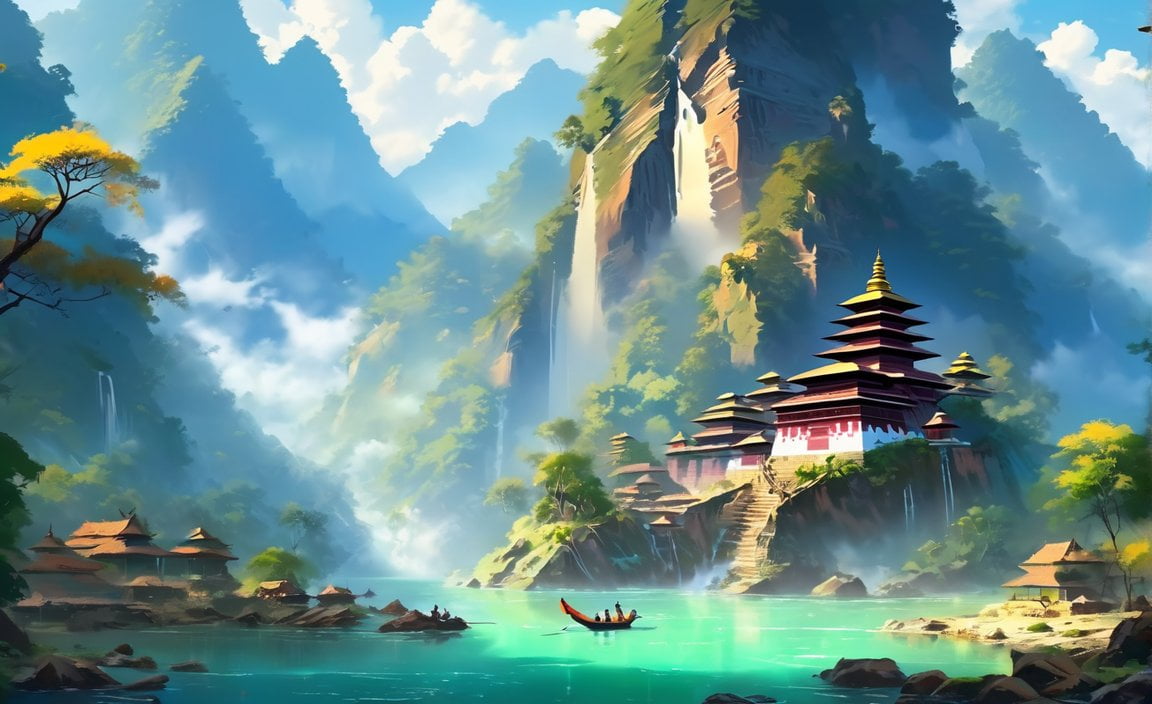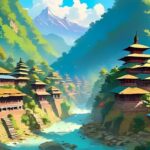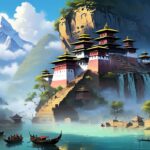Imagine a land where majestic rivers meander through enchanting landscapes, their waters reflecting the beauty of the surrounding mountains and valleys. Nepal, a country nestled in the heart of the Himalayas, boasts a network of breathtaking rivers that shape its very essence. From the raging torrents of the Sun Kosi to the peaceful currents of the Kali Gandaki, these rivers are more than just bodies of water – they are a testament to the wild and untamed spirit of Nepal.
Join us on a captivating journey as we unveil the most mesmerizing rivers of this magical land, exploring their unique stories and the profound impact they have on the people, culture, and environment of Nepal.
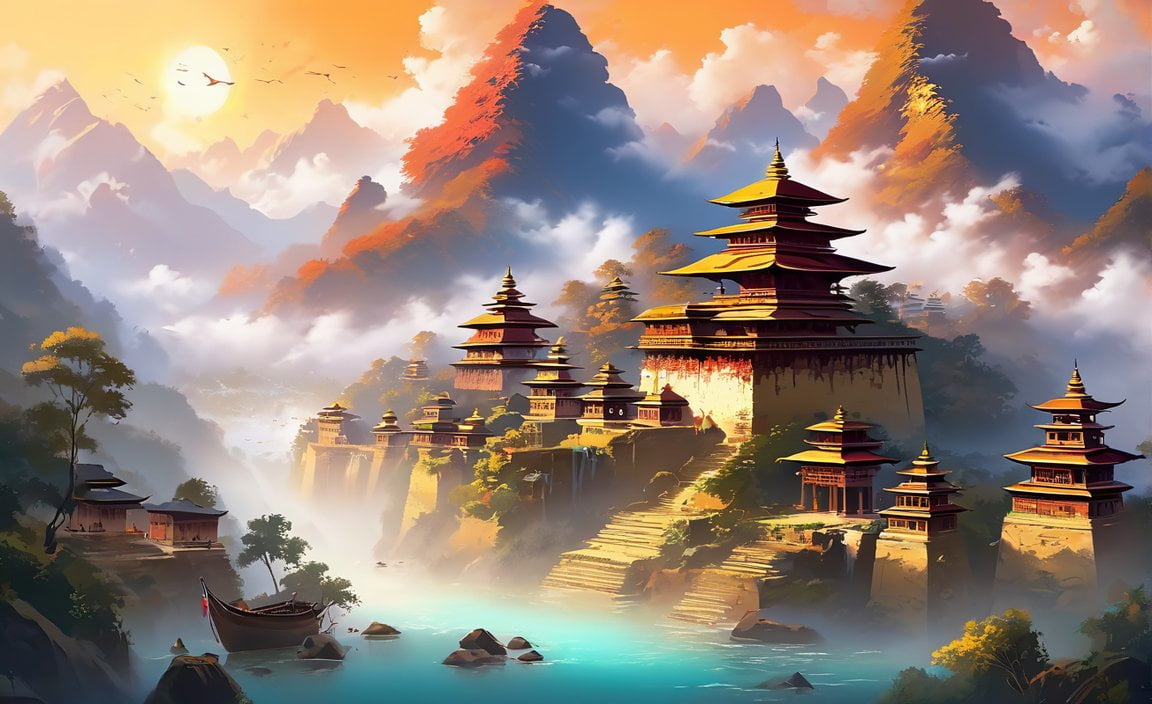
10 Rivers of Nepal
Nepal! Land of towering mountains and vibrant culture! But did you know it’s also a country crisscrossed by an incredible network of rivers? These waterways aren’t just pretty scenery, they’re the lifeblood of Nepal, shaping its environment, its economy, and even its spiritual life.
Let’s dive in (no pun intended!) and get to know 10 of the most amazing rivers Nepal has to offer:
- Sapt Koshi: The Heavyweight Champion – Imagine a river so mighty, it’s formed by seven other rivers coming together! That’s the Sapt Koshi, the undisputed king of Nepal’s rivers. This giant drains a massive area – we’re talking over 74,500 square kilometers! – before it eventually flows into India.
- Arun River: The Unsung Hero – While the Sapt Koshi gets all the glory, its tributary, the Arun River, is no slouch. It contributes over half the water to the Sapt Koshi basin, making it a pretty big deal in its own right!
- Karnali River (Ghaghara River): The Border Crosser – Rivers don’t care about borders, and the Karnali is a perfect example. This river begins its journey in the Himalayas, then flows through Nepal and India, providing water for people in both countries. Talk about international cooperation!
- Kamala River: The Lifeline of Farmers – The Churia Range is the starting point for the Kamala River, which winds its way through Nepal, providing much-needed water for farming. Without the Kamala, many agricultural areas would struggle, demonstrating how essential rivers are for life.
- Bheri River: The Adventure Seeker’s Paradise – The Bheri River cuts through the Karnali Basin, creating an incredible landscape that’s not for the faint of heart. Adventurous types flock here for white-water rafting, testing their mettle against the river’s currents.
- Seti River: The Picture-Perfect Beauty – If postcards were rivers, the Seti River would be on the cover. Flowing through the stunning Pokhara Valley, the Seti’s clear waters and breathtaking surroundings make it a favorite spot for photographers and anyone who appreciates natural beauty.
- Kali Gandaki River: The Gorge-ous One – The Kali Gandaki River holds a special place in the hearts of many Nepalese as a sacred river in Hinduism. But it’s also a geological marvel, carving its way through the deepest gorge on the planet! Talk about a view!
- Rapti River: The Plains Provider – Winding its way across the fertile plains of Nepal, the Rapti River is a source of life for countless communities. It’s a lifeline for agriculture and helps sustain the livelihoods of many people.
- Budhi Gandaki River: The Thrill Seeker’s Dream – The Budhi Gandaki is not just another pretty river. It’s earned its place among the top 10 rafting destinations in the world! Originating in the Ganesh Himal, this river offers an adrenaline-pumping experience as it rushes through breathtaking landscapes.
- Babai River: The Pristine Paradise – The Babai River, flowing from the Mahabharat Range, is a testament to nature’s purity. Known for its crystal-clear waters, it supports a rich variety of aquatic life.
These ten rivers are just a glimpse into the vast network of waterways that make Nepal so special. They’re a reminder of the power and beauty of nature, and the crucial role they play in supporting life in all its forms. So, next time you plan a trip to Nepal, be sure to add these rivers to your itinerary and witness the magic firsthand!
Here is a list of 10 rivers of Nepal: 10 rivers name of Nepal in Nepali. Discover the beautiful names and explore their significance in the Nepali language.
Learn about the diverse rivers that flow through Nepal: 10 rivers of Nepal. Each river has its own unique story, waiting to be explored.
Find out how river water can be utilized in various ways: 10 uses of river water. From agriculture to hydropower, rivers play a crucial role in our daily lives.
Explore the multiple benefits that rivers offer: 10 uses of rivers. Discover how they contribute to transportation, tourism, and the environment.
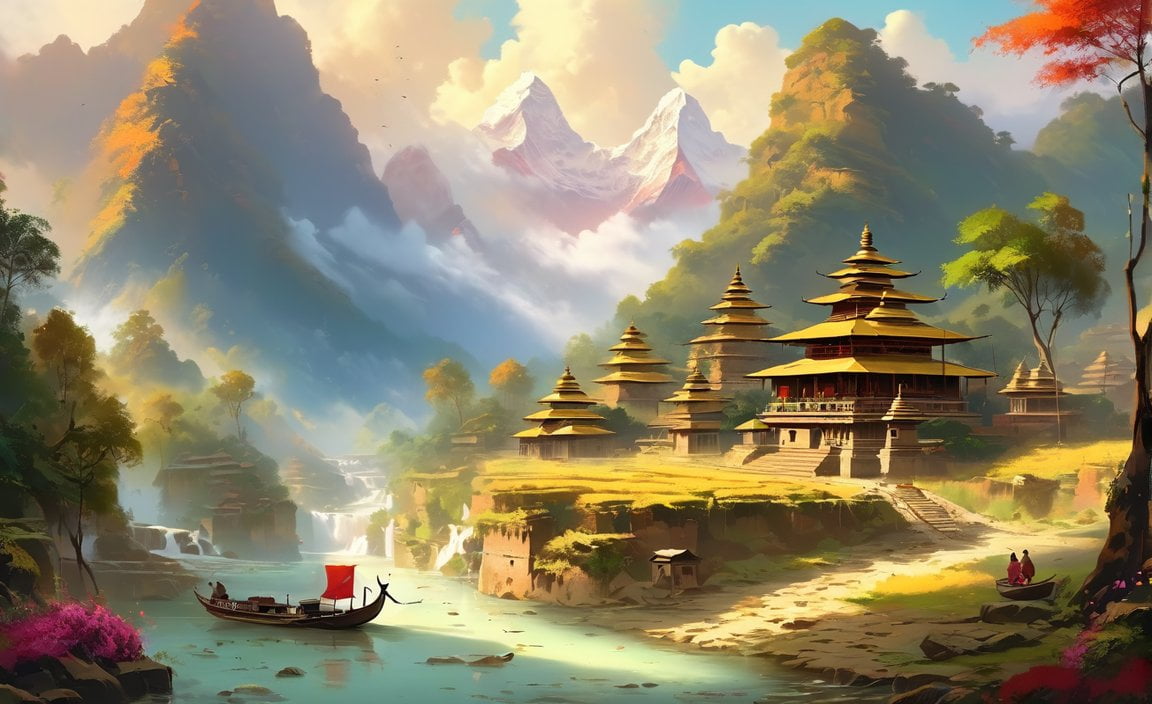
What are the 10 rivers in Nepal?
We’ve been talking about the amazing rivers of Nepal, and now it’s time to share some insider knowledge about ten of these natural wonders! These aren’t just any rivers; they’re like the veins of the country, pumping life and energy into everything around them. Where would Nepal be without its rivers? They’re the reason for the lush valleys, the source of incredible energy, and they’ve even shaped the beliefs and traditions of the Nepali people.
Let’s dive into the top 10 rivers that make Nepal so special!
| River | Length (km) | Source | Interesting Fact |
|---|---|---|---|
| Koshi | 720 | Tibet | Also known as the Saptakoshi, it’s the largest river in Nepal. |
| Gandaki | 630 | Tibet | Famous for its deep gorge, a popular spot for adventure seekers. |
| Karnali | 507 | Tibet | Known for its remote and rugged beauty, attracting intrepid explorers. |
| Mahakali | 576 | India | Forms part of the western border between Nepal and India. |
| Rapti | 251 | Nepal | A haven for wildlife, including endangered species like the Gharial crocodile. |
| Babai | 120 | Nepal | Known for its pristine waters and stunning waterfalls. |
| West Seti | 202 | Nepal | A popular destination for white-water rafting and kayaking. |
| Tamor | 198 | Nepal | Home to diverse fish species and provides irrigation for agriculture. |
| Trishuli | 155 | Nepal | Renowned for its scenic beauty and thrilling rafting opportunities. |
| Arun | 160 | Tibet | Offers breathtaking views of Mount Everest and surrounding peaks. |
These rivers aren’t just pretty faces, though. They’re like the backbone of Nepal’s energy grid. Imagine the power of all that rushing water! Nepal has been tapping into this potential with hydropower projects, which is a big step towards cleaner energy. But it’s a balancing act, right? We need to make sure these projects don’t harm the environment or the people who depend on the rivers.
It’s also important to remember that for many Nepali people, these rivers are sacred, playing a huge role in their culture and beliefs. They aren’t just water; they represent life, purity, and a connection to something bigger.
Speaking of connections, did you know that what we do upstream can impact communities and ecosystems way downstream? It’s like a ripple effect! Deforestation and pollution are serious threats to the health of these rivers. And then there’s climate change. It’s messing with rainfall patterns and glacial melt, which can lead to unpredictable water flow and even dangerous flooding.
Protecting these rivers isn’t just about Nepal; it’s a global responsibility. We need to be mindful of our impact and support sustainable practices that benefit both people and the environment.
So, there you have it! Ten amazing rivers, each with its own story to tell. From their breathtaking beauty to their cultural significance and ecological importance, these rivers are the lifeblood of Nepal. It’s up to us to protect them for generations to come!
How many rivers are there in Nepal?
This tiny country tucked away in the Himalayas is bursting with rivers – over 6,000! Imagine that, a landlocked nation practically overflowing with waterways. It really highlights how crucial water is to Nepal’s identity.
Now, out of these thousands, some rivers stand out more than others. Take the Koshi River, for example. This giant practically owns a quarter of Nepal! It’s a lifeline for the people there, providing water for their crops, their homes, you name it.
Nepal’s rivers are more than just water sources, however. They’re teeming with life! From tiny fish you’ve never even heard of to creatures uniquely adapted to the Himalayan waters, there’s a whole world down there. And it’s all thanks to these rivers that snake their way from the icy mountain peaks down to the flat plains of the Terai region.
Speaking of the Terai, did you know that the landscape actually shapes how these rivers flow? Up in the mountains, they’re fed by melting glaciers, so they’re wild and powerful. But as they reach the flatter lands, they slow down, meander around, and create these fertile floodplains. It’s pretty fascinating how nature works, isn’t it?
So, while we might not know the exact number of every little stream and tributary, one thing’s for sure: Nepal’s rivers are a vital part of what makes this country so special. They’re a source of life, a haven for biodiversity, and a testament to the power and beauty of the natural world.
Who is the biggest river in Nepal?
We’ve been exploring the incredible rivers of Nepal, but which one takes the crown for the absolute largest? That honor goes to the mighty Karnali River. This river isn’t just long, it’s Nepal’s longest, flowing through some of the most stunning scenery you can imagine.
Now, Nepal isn’t a one-river wonder. Each of its rivers has its own personality and plays a unique role. Let’s dive a little deeper:
- Koshi River System: Think of a river system like a family, with the main river and all its tributaries. The Koshi River System is like the biggest family reunion in Nepal, covering a massive 45% of the country. This system is vital for agriculture – it’s literally the lifeblood for millions of people and their livelihoods.
- Gandaki River: Ever wanted to raft through a gorge? The Gandaki River carves its way through one of the most impressive gorges you’ll ever see, forming a natural border between Nepal and India. Besides its beauty, the Gandaki is teeming with fish, making it a haven for anglers.
- Kamala River: Imagine vast fields of crops, all thirsty for water. That’s where the Kamala River comes in. Originating in the Churia Range, this river is essential for eastern Nepal’s agriculture, supporting a thriving economy.
- Bheri River: The Bheri River is unique because it’s a homebody – unlike some of its neighbors that cross borders, the Bheri flows entirely within Nepal. This scenic river is famous for its rapids, attracting adventurous kayakers and rafters.
Think of Nepal’s rivers as more than just water flowing downhill. They’re like veins, carrying life and culture throughout the country. From the thunderous rapids of the Sun Kosi to the tranquil waters of the Kali Gandaki, each river has stories to tell and traditions woven into its currents.
However, these rivers face real challenges from pollution, deforestation, and the impacts of climate change. Protecting them isn’t just about preserving breathtaking beauty, it’s about safeguarding the lives and livelihoods of the people who depend on them.
Here’s a recap of what we’ve learned:
- The Karnali River takes the prize for the biggest and longest river in Nepal.
- The Koshi River System is like Nepal’s giant water network, crucial for a huge chunk of the country.
- The Gandaki River isn’t just a pretty face; it marks a natural border and offers incredible adventure opportunities.
- The Kamala River is the unsung hero of eastern Nepal’s agriculture.
- The Bheri River stays true to its roots, flowing entirely within Nepal and attracting thrill-seekers.
- Protecting these rivers is essential – they’re not just beautiful, they’re lifelines.
What are the 7 rivers of sapta koshi?
Let’s get to know the stars of the show – the seven rivers that come together to form the mighty Saptakoshi. Think of it like this: the Saptakoshi is a team made up of some seriously impressive rivers. Each one has its own personality and story, and when they join forces, they create something truly spectacular.
So, who are these watery wonders? We’ve got the Tamor, the Arun, and the Sun Koshi, each bringing its own unique flow and character to the mix. Then there’s the Dudh Koshi, known for its milky-white waters, and the Tamakoshi, which can be a bit of a daredevil with its rapids. And let’s not forget the Likhu and Bhote Koshi, adding their own special something to this river family reunion.
These seven rivers aren’t just pretty faces; they’re the lifeblood of eastern Nepal. Imagine them as veins and arteries, carrying vital resources like water and fertile soil throughout the region. They’re also ancient highways, used for transportation and trade for centuries.
But the Saptakoshi and its tributaries offer more than just practical benefits. They’re steeped in cultural and spiritual significance, too. Take the Triveni, for example. This sacred spot, where three of the rivers meet, is a major pilgrimage site for Hindus. Imagine the stories these waters could tell! And if you’re an adrenaline junkie, the Sun Kosi offers some of the best white-water rafting in the world.
However, these incredible rivers face challenges, like pollution and the effects of climate change. Protecting them is crucial, not just for the people and wildlife that depend on them, but for the future of this beautiful planet.
Key Takeaways:
- The Saptakoshi River is formed by seven individual rivers: the Tamor, Arun, Sun Koshi, Dudh Koshi, Tamakoshi, Likhu, and Bhote Koshi.
- These rivers are essential for life in eastern Nepal, providing water, fertile land, and transportation routes.
- The Saptakoshi region is a hotspot for adventure tourism, particularly white-water rafting and kayaking.
- The Triveni, a confluence of three rivers, is a highly revered pilgrimage site.
There’s still so much to learn about these fascinating rivers! Keep exploring, keep asking questions, and who knows what other amazing secrets you’ll uncover about the seven rivers of Sapta Koshi.
Which River Touches 10 Countries?
We’ve journeyed through the majestic mountains and serene valleys carved by Nepal’s stunning rivers, but now, let’s shift our focus to a different corner of the world. Which river is impressive enough to touch ten different countries?
The answer is the mighty Danube River. This isn’t just some river; it’s practically a celebrity in the world of waterways! It holds the title of the second-longest river in Europe, outdone only by the grand Volga River.
But the Danube is more than just impressive length. It kicks off its incredible journey in the Black Forest region of Germany. From there, it charts a course through (take a deep breath) Austria, Slovakia, Hungary, Croatia, Serbia, Bulgaria, Romania, Moldova, and finally, Ukraine before it finally meets the Black Sea. Talk about a world tour!
The Danube has witnessed empires rise and fall, seen conflicts and periods of peace, and acted as a crucial artery for trade and cultural exchange for centuries. It’s no wonder it’s often called the “lifeblood of Europe.” Goods, ideas, and people have traveled along this river for ages. It’s like a watery thread connecting vastly different cultures and landscapes.
How many of the top 10 mountains are in Nepal?
So, we’ve talked about the rivers that wind through Nepal, but now, let’s talk about those massive, sky-piercing mountains. You know, the ones that make you feel tiny just by looking at them? It’s pretty mind-blowing to think about, but Nepal actually holds a world record when it comes to these giants.
Think about this: Out of the 14 mountains on our planet that rise over 8,000 meters (that’s crazy high!), a whopping 8 of them are nestled within Nepal’s borders. That’s like having the all-star team of mountains right there in one country!
Now, if you’re wondering where to find most of these majestic peaks, look no further than the Khumbu Pasanglhamu region. Yep, that’s the one that’s practically synonymous with Mount Everest, the big kahuna of them all.
But here’s the thing – researchers are always exploring, and sometimes, even the mountains themselves shift and change. It’s possible that new data could emerge, changing our understanding of their heights and rankings. Pretty cool, right?
So, while we can say with pretty high confidence that Nepal is home to a huge chunk of the world’s tallest mountains, it’s always a good idea to keep an eye out for new discoveries. After all, the Himalayas are full of surprises!
Which river is holy in Nepal?
Okay, so we’ve talked about the amazing rivers in Nepal, but there’s one that’s a little extra special to the locals: the Bagmati River. This river isn’t just a source of water; it’s deeply intertwined with the spiritual beliefs of both Hindus and Buddhists, making it something like a sacred thread running through Nepal’s cultural tapestry.
The Bagmati River begins its journey high up in the Shivapuri Hills, eventually making its way down through the Kathmandu Valley, where it gracefully flows between the cities of Kathmandu and Patan. This location isn’t random; it’s at the heart of Nepal’s cultural and spiritual centers, further solidifying the river’s importance.
Now, why is the Bagmati considered so holy? Well, many believe it’s a living embodiment of the goddess Bagwati, an important aspect of the Hindu goddess Durga. Imagine for a moment the reverence people must feel, believing that the river itself is a goddess! It’s no surprise that taking a dip in the Bagmati is thought to cleanse you spiritually, washing away any negativity.
And it’s not just the water; the banks of the Bagmati are like an open-air temple. You’ll find all sorts of shrines and temples dedicated to various gods and goddesses, making it a place where people go not just to worship, but also to connect with something bigger than themselves. It’s a powerful reminder that in Nepal, spirituality is woven into the very landscape.
However, it’s not all sunshine and roses for the Bagmati. Modern life, with its growing cities and industries, has unfortunately taken its toll. Pollution is a serious concern, and efforts to clean up the river and restore it to its former glory are ongoing. It’s a delicate balance—preserving both the environment and the deep spiritual connection people have with the Bagmati.
What are the seven rivers?
Picking up where we left off, let’s dive into the magnificent seven rivers that grace Nepal. These aren’t just any bodies of water; they’re like the veins of the country, each one pulsing with its own unique character and charm.
- Karnali River: Imagine a river born in the high Tibetan plateau, then picture it dramatically carving its way westward through deep gorges and plummeting over cliffs that have been sculpted by centuries of nature’s handiwork. That’s the Karnali River for you. It’s a powerful force, providing livelihoods for countless communities who rely on it for farming and trade.
- Gandaki River: If rivers could be celebrities, the Gandaki would be Nepal’s most revered star. Originating from the breathtaking Annapurna Himalayas, it meanders through some of the most stunning scenery you can imagine. The Gandaki is more than just a river; it’s a sacred symbol of Lord Vishnu, its peaceful flow a stark contrast to the rugged beauty surrounding it. It’s no wonder this river draws in both pilgrims seeking spiritual connection and nature lovers yearning for awe-inspiring vistas.
- Sun Kosi River: Picture this: the imposing peaks of Mount Everest reflected in the turquoise waters of a rushing river. That’s the Sun Kosi, a river that bursts forth from the glaciers of the Everest region and carves its path through the heart of the Himalayas. For thrill-seekers, it’s a playground of whitewater rapids perfect for rafting and kayaking, all set against the backdrop of the world’s highest mountain.
- Tamur River: In the remote and unspoiled Taplejung district flows the Tamur River, a hidden gem that feels like a secret escape. Its crystal-clear waters mirror the lush greenery that thrives along its banks, providing a vital lifeline for the communities nestled in this remote corner of Nepal. The Tamur’s gentle currents offer a serene escape for those seeking tranquility amidst the raw beauty of Nepal’s eastern edge.
- Marshyangdi River: Born from the glaciers of the Annapurna Mountains, the Marshyangdi River cuts through narrow canyons and spills into fertile valleys. Its clear, pristine water is a sight to behold, especially as you imagine rafters paddling alongside traditional terraced rice fields and breathtaking waterfalls. For adventure enthusiasts and nature lovers seeking an unforgettable journey into the heart of the Himalayas, the Marshyangdi is calling.
- Trishuli River: Emerging from the Langtang Himalayas, the Trishuli River surges through a picturesque valley before merging with the mighty Narayani River. Known for its thrilling rapids, it’s a magnet for adrenaline junkies seeking to conquer its whitewater challenges. But the Trishuli offers more than just thrills. As it winds through the countryside, it reveals a tapestry of terraced fields, lush forests, and charming villages, creating a captivating blend of excitement and serenity.
- Seti River: Imagine yourself in the breathtaking Pokhara Valley, gazing upon the emerald-green waters of the Seti River. This enchanting river is like a tranquil oasis, its banks adorned with peaceful gardens and charming bridges. It offers a refreshing contrast to the lively city of Pokhara, inviting nature lovers to lose themselves in its pristine beauty.
Think of it this way:
- We’ve journeyed through Nepal, discovering the Karnali, Gandaki, Sun Kosi, Tamur, Marshyangdi, Trishuli, and Seti, each river leaving its own unique mark on the landscape.
- From the adrenaline rush of white-water rafting to the peaceful serenity of kayaking amidst majestic mountains, these rivers offer something for everyone.
- More than just scenic wonders, they’re the lifeblood of communities, providing sustenance and shaping the very essence of Nepal’s natural and cultural heritage.
- While the Karnali takes the crown as Nepal’s longest river, the Gandaki holds a special place in the hearts of many as the most sacred, drawing pilgrims and nature enthusiasts alike.
- And who could forget the Sun Kosi, daring adventurers to test their mettle against its rapids while standing in awe of the mighty Mount Everest?
Is there 24 rivers in Pakistan?
My journey through Nepal’s rivers has been nothing short of amazing. Each one has its own personality, from the powerful rush of the Sun Kosi to the peaceful flow of the Kali Gandaki. These rivers aren’t just water flowing through; they’ve shaped the land and the lives of the people here. But when we talk about the number of rivers, things can get a bit tricky.
While some sources might say there are 24 rivers in Pakistan, that number might not tell the whole story. Pinning down an exact number for a country’s rivers is harder than you might think. What counts as a “major” river versus a smaller tributary? Geographic definitions can be fluid, and different studies might use different criteria.
Instead of focusing on a specific number, it’s more helpful to appreciate the sheer network of rivers and streams that make up Pakistan’s water system. The Indus River, for example, is the undisputed king, a lifeline for the entire country. But feeding into the Indus are countless smaller rivers, each with its own unique ecosystem and importance to the local communities.
So, while the exact number of rivers in Pakistan might remain a bit of a mystery, one thing is certain: their impact on the landscape, culture, and people is undeniable.
Which Country Has the Most Rivers?
So, we’ve been talking about countries with a whole lot of rivers. It’s a tricky thing to measure precisely because, let’s be honest, what exactly counts as a “river?” A little stream might be important to locals, but does it make it onto a world map? But even with that uncertainty, there’s one country that keeps popping up: Nepal.
Think about it: Nepal is nestled right up against the Himalayas, those giant mountains that practically touch the sky. All that snow and ice up there has to melt somewhere, right? That’s where the rivers come in. Nepal might not be the biggest country, but it’s jam-packed with over 6,000 rivers and streams! That’s a whole lot of water flowing through some seriously stunning landscapes.
We’re talking rivers that carve through mountains, rivers that meander through valleys, rivers that are practically sacred to the people who live near them. It’s not just about the numbers, though. Nepal’s rivers are like the veins of the country, giving life to everything from farms to ancient temples.
Could Nepal really have the most rivers? Well, it’s tough to say for sure. Some experts think other countries like Russia or China might actually have more, but it depends on how you count them. What we do know is that Nepal is a top contender, and its rivers are a huge part of what makes it so special.
Key Points about Nepal’s Rivers:
- Extensive Network: Nepal has an extensive network of rivers that shape its environment, economy, and spirituality.
- Sapt Koshi: The largest river, formed by the convergence of seven smaller rivers (Tamor, Arun, Sun Koshi, Dudh Koshi, Tamakoshi, Likhu, and Bhote Koshi).
- Arun River: A major tributary to the Sapt Koshi, contributing half its water.
- Karnali River: The longest river in Nepal, flowing through both Nepal and India, providing water to people in both countries.
- Kamala River: Essential for agriculture in the Churia Range.
- Bheri River: A popular destination for white-water rafting.
- Seti River: Known for its clear waters and scenic Pokhara Valley surroundings.
- Kali Gandaki River: A sacred river in Hinduism, also renowned for its deep gorge.
- Rapti River: A source of water and life in the fertile plains of Nepal.
- Budhi Gandaki River: One of the top 10 rafting destinations in the world.
- Babai River: Pristine waters support abundant aquatic life.
Key Insights about Nepal’s Rivers:
- Biodiversity Haven: Nepal’s rivers support a rich diversity of flora, fauna, and the livelihoods of riparian communities.
- Hydropower Potential: The cascading waters offer immense hydropower potential, contributing to sustainable energy production and economic development.
- Cultural Tapestry: Rivers hold profound cultural significance, shaping religious beliefs, pilgrimage destinations, and the fabric of Nepalese society.
- Conservation Challenges: Human activities, climate change, and pollution pose significant threats to river health, necessitating conservation efforts to preserve their ecological integrity.
Wondering about the most important waterways of Nepal? Discover the 10 Rivers of Nepal that shape the country’s geography and provide sustenance to its people.
